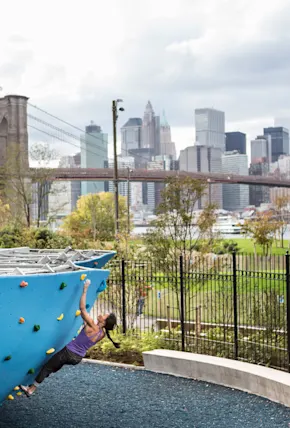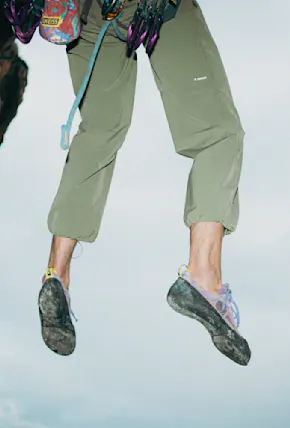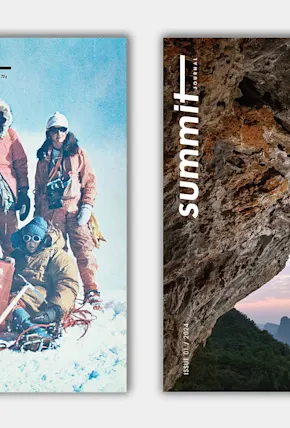At a grand elevation of 46 feet, Boston isn’t on anyone’s list of America’s great rock climbing cities. But it just might make the cut as a wicked good climbing city—with local options to test the tendons and access to world-class crags if you’re OK with driving a couple hours.
When watching the Sox, Pats, C’s or B’s brings your blood pressure to an unhealthy level, consider the options below to get your hands on some of New England’s best granite, gneiss, and schist. Or, you know, plastic.
Local Knowledge
For local know-how, the gyms are going to be a good resource for getting crag info and last-minute rock shoe pick-ups if you’re worried your old Skwamas are running low on rubber. If you’re one of the many students in the city, there are zillions of deals and discounts to scope out. For a general area guidebook, the second edition of Boston Rocks gets the job done; it’s 20 years old, but the rocks are still there. Mountain Project is always great for getting the lay of the land, but if you find yourself going back to the same spots, consider the Rumney or Pawtuckaway guide books. And while there are plenty of REI-style options to pick up a new rope or a few extra quickdraws, you’re going to have to drive up to North Conway for a true-blue climbing store. There, International Mountain Equipment has got it all, including the best consignment shop east of New Paltz.
If you grew up in Massachusetts, you already know about layering. If not, prepare for big swings in temperature with a solid puffy most months of the year. Bug spray is a must in New Hampshire during any month when the leaves are green. Winter bouldering days are doable if it’s sunny and dry; just wear long johns if you really want the temps to send hard. If you’re going sport climbing, it’s best to get your own gear, but crash pads are available for rent from Rock Spot gyms.

Predator 5.13b at Rumney, NH | Photo courtesy Jodie Morse
Outdoor Climbing in the Boston Area
Climbing, for all its upsides, requires a car in pretty much every region of the country—and Boston is no exception, save for the Quincy Quarries, which you can haul your gear to on the bus. But if you time the traffic right, there’s tons of bouldering, sport, and trad of all grades within a two-hour drive, including some of the best schist known to man.
Rumney, New Hampshire
This cliff at the very southern tip of the White Mountain National Forest is the premier option in New England. Located two hours from Boston with weekend traffic, you could climb from your first day until your knees, shoulders, and toes give out and never get bored on Rumney schist. (It would be a shame if you never got to the gnarly trad and alpine climbing in the Whites, but you’ll never be bored at Rumney.) It’s great for beginners, with many easy approaches and dozens of sport routes in the low fives. It is bolted out like a gym and there are even signs telling you which way the individual crags are. Not exactly the backcountry! For the moderate climber, there are plenty of 5.10s, 5.11s, and 5.12s that are challenging and unique for the grade. And if you’re top notch, take on the stout stuff on the overhung paradise of Waimea—or see if you can chase down the guide-book-cover classic, Predator.
Rumney Climbing Tips
Go in the fall for serious climbing temps and leaf-peeping. But if you’re not going to storm China Beach, July and August are totally underrated Rumney months. New Hampshire rules in the summer. Climb hard in the morning before it heats up, then dip in the Baker River across the street from the parking lot. For other swimming options, Sculptured Rocks and the exquisitely-clear Newfound Lake are 20 minutes away.
Bring a few crash pads to take on Zig Zag Crack, the best V1 you may ever pull on. It climbs like a dream but the top-out is pretty tall. If height makes you wobbly, consider dialing in the layback on top-rope via the trusty bolt up top. Then give it the Instagram go.
The closest Dunks is on Route 25 just off the main highway. Kill a mild hangover with two orders of hashbrowns and an iced regular.

Quincy Quarries | Photo courtesy Luke Foley
Quincy Quarries
If Rumney is the best climbing within a 200-mile radius, Quincy is the most unique. Does it technically suck? Well, yeah. Thanks to years of taggers practicing on the old quarry, the first 20 feet require you to climb through multiple layers of spray paint slicked onto the granite. But if you can top-rope your way past the paint, it’ll help you get confident enough to pull on actual rock in the worst of conditions—and in damp New England, there are a lot of bad conditions. And just a few miles out of the city and reachable by bus, it’s a great place to take friends for a half-day to see if they actually like climbing outside or want to stick to gym plastic.
On the largest face in the quarry, Pins and The Power of Positive Thinking are the top-rope king lines, but plenty of short 5.5s dot the area. Scramble up the backside to set up TRs for most routes—it’s not really worth trying the few sport options considering the potential for ground fall from the first few bolts, where the paint makes the holds unreliable. Paint aside, it’s a great place to hone your anchor and belay skills, or to do a spooky first walk-off rappel on the main wall. The first climbers at Quincy actually used it as a training ground before taking on headier stuff in New Hampshire and in the Gunks in New York. Just remember that gravity is still on.
Lynn Woods and Cape Ann
Boston’s North Shore harbors a surprising bit of granite bouldering, with most of it scattered around the Cape Ann peninsula that includes old fishing towns like Gloucester and Rockport. The beehive boulders at Dyke’s Pond are worth a trip up Route One all on their own. A number of quality low-grade challenges dot the woods around Final Judgement, a V6 on a prow that is both slappy and delicate. (If it’s summertime, cool off at Singing Beach just down the road.) A little closer to Boston is the Lynn Woods Reservations. It has over 1,000 problems alone, including The Buttermilker—a V7 with all the movement one could ever ask for in a line.
Whitney and Thayer Woods
There’s a lot more bouldering on Boston’s North Shore than the South—as you might expect when comparing the coastline, where the north starts to look like the rocky Maine coastline and the south tends to be more marshy. But there are some scattered gems down in the Whitney and Thayer Woods in Scituate. The Skyline Wall has some tall warm-ups; test your ability with heights on some increasingly high problems leading up to a no-joke V4. Or head to the Bigelow boulder for some lower problems, like a tough, one-move V4, a soft V6, and a lowball V7 that feels more like wrestling than climbing.
Pawtuckaway State Park
Thank the glaciers for delivering these top-notch boulders to the woods of southern New Hampshire an hour north of the city (on weekend days). Heady V0s like Cream will get your heart pumping even if your forearms don’t feel it yet. V2 fingerlocks? Reachy V3 traverses and knee bars? Pawtuckaway has it all—including one of the best V6s on the East Coast in Ride the Lightning. Follow the charming and obvious line and commit for the slopey mantle up top.
Western Massachusetts Climbing
There’s killer climbing in the Berkshires, but there’s also a general rule not to post too much information online to keep everything on an even keel with the tony locals. But that doesn’t apply to the newly established crag of Hanging Mountain—a 1,000-foot long range of cliffs of mixed rock with a great selection of routes under 5.10. As is the case with all new spots, look out for choss and keep that helmet on.

















